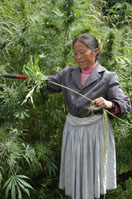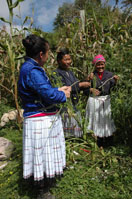|
Fiber,Textile-Hemp,
Ramie in Northwest Guizhou
According
to historic documents and unearthed fiber materials, it is believed
that hemp fiber has been started using since the New neolethic period
in China-some 6000 years ago. As one of the most famous three ancient
tribes of China, the Miao ancestors in the Chu kingdom of the Waring
States period(475-221 BC) has already skillfully planted and used
hemp. With the popular use of cotton in China, hemp fiber disappeared
in central China and is stronly used by the Miao in southwest China,
to be specific, the northwest of Guizhou.
 |
| 1
Cutting hemp |
When I was
a little child, I still saw many Miao women in my village plant
ramie for making clothes and shoes, however it's very, very hard
to find this secret fiber in my village and nearby regions, just
some Miao families in northwest Guizhou still keep this fiber and
the skill-planting hemp, cutting hemp, scraping peel, drying hemp
threads, twisting threads, winding threads and weaving threads.
it seems it will be seen no more soon in those remote regions, for
this purpose, I decide to write this article and share some of my
pictures with you.To be frank, I've been to northwest Guizhou for
exploring Miao's fibers and textiles lots of times, at least once
to three times a year since 1998, of course I really enjoyed my
trip to those regions and I like them. But I never had an idea to
write an article about that region, recently I found many, many
Miao families there don't grow hemp, ramie any more, I need to do
something, then there came the chance, last October, Tessa Bunney-a
British photographer went to that region with me to take some pictures
of Miao fibers and embroidery stitches, I was the tour operator
and guide for her, I also took some great pictures, so here the
story goes.
 |
| 2
Removing leaves |
Usually the
Miao harvest-cut hemp or ramie twice or three times a year, some
regions, twice a year, some regions, three times, for instance,
the Big Flower Miao and the Red thread Miao's regions, it's three
times a year, the Small flower Miao and the Long Skirt Miao's region(my
region), it's two times a year. some regions in Southeast Guizhou,
it's also twice a year. Generally speaking, the first time of harvesting
is on the late 5th or early 6th lunar month, the second time is
on the 9th lunar month. If they harvest three times a year, the
first time would be on the 5th lunar month, the 7th lunar month
for the second time and 10th lunar month for the third time. But
it's unnecessary to grow hemp or ramie every year, because the roots
are still left in the fields when stems are cut, the young plants
can grow from the old roots.
After cutting
the hemp stems and removing leaves, Miao women can peel the skin
immediately on the same day, some regions, they can keep at home
or outside the house for a while such as 20-30 days, I saw Miao
women scrape the skin at once on the same day in the Big Flower
Miao villages and Red Thread Miao villages, but I also saw Miao
women in the Long Horned Miao villages scrape skin when the hemp
stems are very drying. I don't why they do it in different ways,
but from the point of mine and my mother, we do think it's more
easy to scrape the skin when they are just cut from the fields and
fresh, my mother had already practised this skill for many years
since about 50 years ago, and just stopped 15 years ago.
 |
| 3
Scraping inner bast from bark |
After getting
inner basts from hemp stems, Miao women burn rice straw to get some
ash, then use a piece of cloth to wrap the ash and boil them together
with basts. After that, they clean the basts with fresh water and
dry in the sun. My mother says the purpose of using rice straw ash
is to let the basts more white. In some regions, hemp threads are
coated with beeswax to make shoes.
In different
areas, Miao women have different tools for twisting, winding, spinning
and weaving hemp threads. When Tessa Bunney and me got to a Big
Flower Miao village, we found only two families still grow hemp
and ramie in the whole village, a some 130 family village, we tried
hard to find a home, and they agreed to take a very old wooden tool
for winding hemp yarn from the inside of the house. They also brought
us an old loom and give us the demonstration of weaving hemp. It
seems they don't use those tools for a while. I heard
some Miao in the south of Sichuan use a bamboo basket for winding
hemp yarn, but I have never been there and never saw one beforIn
different areas, Miao women have different tools for twisting, winding,
spinning and weaving hemp threads. When Tessa Bunney and me got
to a Big Flower Miao village, we found only two families still grow
hemp and ramie in the whole village, a some 130 family village,
we tried hard to find a home, and they agreed to take a very old
wooden tool for winding hemp yarn from the inside of the house.
They also brought us an old loom and give us the demonstration of
weaving hemp. It seems they don't use those tools for a while. I
heard some Miao in the south of Sichuan use a bamboo basket for
winding hemp yarn, but I have never been there and never saw one
before.
 |
| 4
Peeling bark from stem |
In the Miao
villages in the northwest of Guizhou, after weaving hemp, they use
hemp cloth for making women's skirts, jackets and men's aprons,
lobes or turbans. They said hemp is more durable. During festivals
or market days, you still can a few old Miao people in hemp clothes,
but many of the young girls start to wear a kind of very new material
sold at the market, it became the young's favourite. It's too sad
to see the Miao begin to forget this secret and precious tradition-growing
hemp. I hope the pictures I took with Tessa Bunney will be a treasure
for them in some day in the future, maybe this will make me feel
much better, because I'm also Miao, I'm also from the countryside
and grew up there, that's my homeland. As tree leaves fall to the
ground while trees are old, I will go back to my village and spend
my last life time when I get old.
For exchanging
Miao textile or embroidery stitches information or even making tours
with me, for private tours, just contact me, see my website http://
www.alongdiscovery.com for more information.
Please remember
the Miao I wrote on the articles live in a very remote region, the
road is bad and there is little travel information about them, many
farmers raise dogs for guarding their homes, and they usually are
busy working in the fields since early morning, so the region is
not encouraged to visit. If you really have interests and you don't
mind traveling on bad road and staying at just ok hotels, you can
go there. To find a real Guizhou travel expert is very ne cessary.
|

